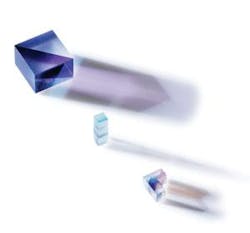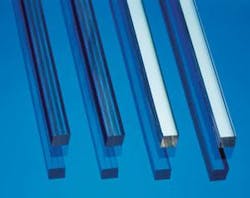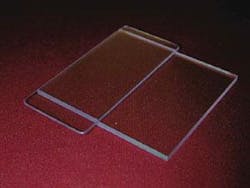OPTICAL FABRICATION: Optical contacting grows more robust
Micro-optic systems consisting of prisms, beamsplitters and other optical components are used across a variety of industries from telecommunications to biophotonics. They can increase the efficiency of fiberoptic and endoscopic imaging systems in medical and biophotonic applications, lock the wavelength of telecommunications transmitters, or increase the lasing efficiency in high-power lasers. The optics in these microsystems are bonded together so that no extra fixturing is required. A variety of processes such as epoxy bonding, frit bonding, diffusion bonding, and optical contacting have been used. The quality of the bond and interface is judged on several criteria, including precision, mechanical strength, optical properties (scattering, absorption, index mismatch, and power handling), thermal properties, and chemical properties, along with the simplicity and manufacturability of the process itself.
One of the most common methods used to adhere two pieces of optical glass is epoxy bonding. The two pieces are coated with epoxy, brought together, and cured (time, temperature, or UV exposure). Epoxy bonding is reliable and manufacturable because it is an inexpensive process with high yield. However, because it leaves an often thick and variable film, it is inappropriate for applications requiring precision thickness control. Scattering can occur in these optically thick interfaces, introducing loss. And, because the epoxy is often made from organic material, these bonds cannot withstand high-intensity optical powers or UV exposure. Moreover, epoxy bonds are not particularly heat resistant or chemically robust. Because the pieces are “floating” on a sea of epoxy, they can move under various thermal conditions. The epoxy can also dissolve with chemical exposure. In a vacuum environment, the epoxy can outgas and contaminate other optics. For these reasons, there is great interest in epoxy-free bonding technologies.
Frit and diffusion bonding
Frit bonding, a process that uses a low-melting-point glass frit as an intermediate bonding agent, is widely used for both optical and MEMs applications. It is an epoxy-free process in which the substrates are polished, cleaned, and coated with a glass frit. The pieces are baked together at high temperatures (in the range of 400°C to 650°C) and with moderate pressure. The benefit is that the bond is mechanically strong and chemically resistant. There are several drawbacks, however. Because the melted glass frit bonds the parts together, the frit must be able to flow between the parts. In some cases, the parts must be grooved to enable the frit to flow evenly, increasing scattering in the final interface. Moreover, the process is expensive because the fixtures must withstand extremely high temperatures. Also, these high temperatures can cause changes in the physical and chemical properties of the materials themselves, including changes in dopant concentrations and/or structural changes.
Another epoxy-free bonding process is diffusion bonding, first developed as a cost-effective method for the fabrication of titanium structural fittings (instead of costly machining) for military aircraft systems including the B-1 bomber and the Space Shuttle. In this process, the two optical pieces are heated and then pressed together. Because the bonding process relies on the atomic diffusion of elements at the interface, the required temperature can be up to 80% of the melting temperature of the substrates themselves (often greater than 1000°C).The atoms migrate through the solid, either by the exchange of adjacent atoms, the motion of interstitial atoms, or the motion of vacancies in the lattice structure; the two glass, ceramic, or metal substrates must be in very close proximity for the diffusion process to take place. Initial surface flatness and cleanliness are essential. Because the material is heated up, expensive fixturing is required, and chemical changes can occur (dopant concentrations can be altered). Onyx Optics (Dublin, CA) uses diffusion bonding as part of its patented AFB (adhesive-free bond) process.
Optical contacting
Optical contacting is a room-temperature bonding process that results in an epoxy-free precision bond. The process results in optical paths that are 100% optically transparent with negligible scattering and absorptive losses at the interfaces. In traditional optical contacting, the surfaces are polished, cleaned, and bonded together with no epoxies or cements and no mechanical attachments.
The technique has a long history—the adhesion of solids was first observed two centuries ago, when Desagulier in 1792 first demonstrated the bonding of two spheres of lead when pressed together.1 Because the sphere deformed in the process, this could not be used for rigid materials such as quartz and fused silica. About a century ago, German craftsmen used the technique “ansprengen” (meaning “jumping into contact”) to stick together two optically polished bulk pieces of metals for precision measurements. They used an analogous method with optically polished glasses for making precision prisms. Nonetheless, it was not until 1936 that a systematic investigation took place with Lord Rayleigh’s studies of the room-temperature adhesion mechanism between two optically polished glass plates.2
Optical contacting has been used for years in precision optical shops to block optics for polishing because it removes the dimensional uncertainty of wax or adhesives. Because the process is not very robust and can be easily “broken,” parts optically contacted in the traditional manner must be sealed around the edges to prevent breaking the contact.
Robust bonds
Today, however, variations on traditional optical contacting can create precise, optically transparent bonds that are robust and mechanically strong (see Fig. 1). These improved processes result in a bond as strong as if the entire structure had been made from a single piece of material, and bonds have even passed Telcordia’s stringent requirements for durability, reliability, and environmental stability. Because these bonds are epoxy-free, they can withstand high optical powers and low temperatures. There is no scattering or absorptive losses at the interfaces and no outgassing. The bond is chemically resistant and can be used with a wide variety of materials; both similar and dissimilar crystals and glasses can be bonded. Modern day uses of improved optical contacting include composite high-power laser optics (structures that have a doped “core” with a different cladding material), micro-optics, cryogenic optics, space optics, underwater optics, vacuum optics, and biocompatible optics (see Fig. 2).
Almost all these improved optical-contacting processes use a variation of “wafer bonding”—analogous to a similar process in the semiconductor industry. These processes include an extra step to create covalent bonds across the interface—a bond that is significantly stronger than that formed from traditional optical contacting. This extra step can be increased pressure, chemical activation, and/or thermal curing.
For example, one solution-assisted process uses an alcohol-based optical cleaning solution (isopropyl alcohol or similar) so the parts can be aligned before the alcohol evaporates.3 This facilitates alignment of the optical components and eliminates one disadvantage of conventional optical contacting: it is difficult or impossible to adjust the alignment once the components have bonded. The solution forms a weak bond that strengthens as the alcohol evaporates, typically about one minute. While this solution-assisted process addresses the alignment issue, there are still tight requirements on the flatness and cleanliness of the pieces.
Chemically activated direct bonding
Another epoxy-free solution-assisted optical-contacting process is chemically activated direct bonding (CADB). Developed by Precision Photonics, it is a highly repeatable and manufacturable process that relies on a well-studied chemical activation. The process results in a bond as strong as bulk material, as precise and transparent as traditional optical-contact bonds, and as reliable as high-temperature frit bonding. Most important, it can be performed with high yields with a variety of materials, including dissimilar materials, and over large areas (see Fig. 3).
In CADB, the parts are polished and physical and chemical contaminants removed. The surfaces are chemically activated to create dangling bonds. The two parts to be bonded are brought into contact with each other, at which point the outer molecules from each surface bond together through hydrogen bonding. The parts are then annealed at a temperature specific to the substrate materials. During annealing (at temperatures well below melting temperatures), covalent bonds are formed between the atoms of each surface, often through an oxygen atom. CADB has been successfully used for a variety of applications, including composite bonding of dissimilar materials, in which it is typically only limited by the mismatch of the coefficient of thermal expansion of the materials. Material combinations successfully bonded together include YAG/sapphire, quartz/BK7, and fused silica/Zerodur.
Chemically activated direct bonding can also be used to bond coated materials. Ion-beam-sputtered (IBS) and ion-assisted coatings are hardy enough to withstand the bonding process. A repeatable and controllable high-energy process, IBS results in dense, durable dielectric thin films. Because the molecules in the IBS process are deposited at a high average energy (unlike evaporative or ion-assisted processes that are low energy), the molecules form covalent bonds. The resulting films are extremely uniform and nonporous and offer superior adhesion. The deposited molecules in the IBS process have energies of approximately 10 eV, or 100 times their thermal energies.
Since it was first observed more than 200 years ago, optical contacting has evolved from a “black art” to a highly manufacturable and repeatable process used in the manufacture of a variety of components. Today’s optical-contacting methods offer increased robustness and flexibility when compared to traditional optical contacting. For example, CADB can bond a variety of crystal, glass, and ceramic materials (such as fused silica, LaSFN9, Zerodur, BK7, ULE, YAG, ceramic YAG, sapphire, YVO4, and doped phosphate glasses), and can also be used over large areas for high-volume applications, even on ion-beam-sputtered and ion-assisted dielectric thin films.
REFERENCES
1. D. Dawson, History of Tribology, Longman, London, 1979.
2. L. Rayleigh, Proc. Phys. Soc., A156, 326 (1936).
3. D. Shaddock and A. Abromovici, NASA Tech Briefs, March 2004, “Solution-Assisted Optical Contacting: Components in optical contact can be adjusted for about a minute.”
Chris Myatt
Chris Myatt is CEO at Precision Photonics (Boulder, CO).
Nick Traggis
Nick Traggis is director of new product development at Precision Photonics (Boulder, CO).
Kathy Li Dessau
Kathy Li Dessau is product manager at Newport New Focus (Santa Clara, CA).


